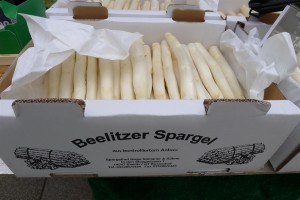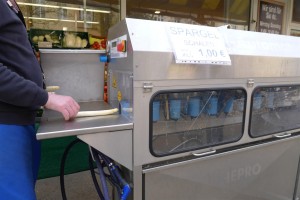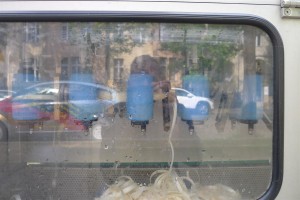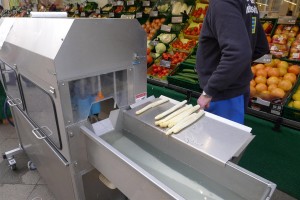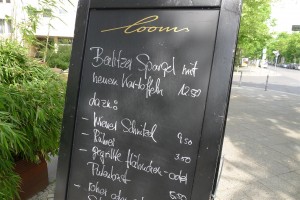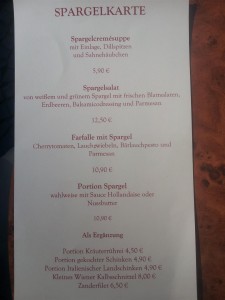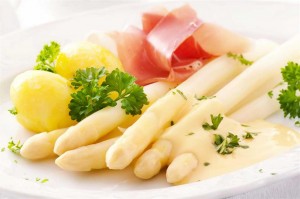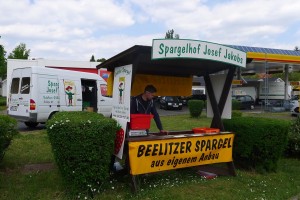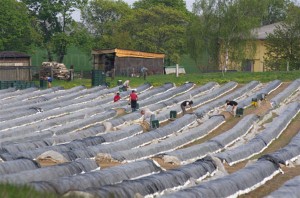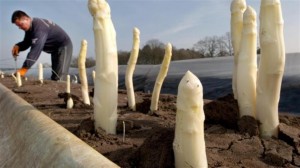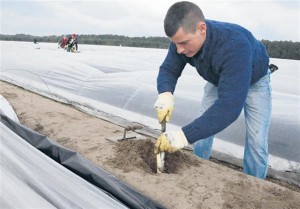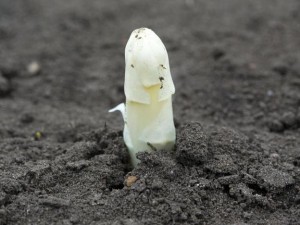We are in the midst of Spargelzeit — asparagus season — here in Germany. This asparagus is not the slim green variety that one typically finds in the US, but rather plump stalks of white asparagus. White asparagus is the same species as green, but it is cultivated differently. Soil is piled over the young shoots as they grow, and opaque tarps ensure that no light reaches the asparagus . In the absence of sunlight, photosynthesis does not occur, and the stalks become etiolated — they remain white.
Fans of white asparagus (every German I know) claim that it is less bitter and more tender than its green counterpart. The stalks also tend to be thicker, because the asparagus is allowed to grow longer. The downside to white asparagus is that the thick skin has to be peeled before it can be eaten. The peeling can be done at home with a vegetable peeler, but for €1.00, our local grocer will send a kilo of asparagus through this peeling machine:
I don’t think it took too many German machine engineers to come up with this contraption. It consists simply of pairs of rollers interspersed with fixed-blade vegetable peelers.
Berliners take Spargelzeit seriously. Every grocer has fresh asparagus for sale, and most restaurants are advertising asparagus specials.
In the classic dish, hollandaise sauce is ladled over steamed asparagus, boiled potatoes and rolls of sliced ham.
I recently passed this stand that had been set up in front of a nearby gas station:
Asparagus from the town of Beelitz, about 60 kilometers southwest of Berlin, is particularly prized here in the city. On the last weekend in May, Beelitz, like many other towns that thrive on asparagus, will celebrate its annual asparagus festival. In addition to fireworks and disco dancing, the three-day program includes performances of an asparagus dance by the Beelitz Asparagus Women, and the crowning of Beelitz’s Asparagus Queen. A Polish orchestra will also be performing, perhaps because many of the asparagus harvesters are seasonal workers who hail from Eastern Europe. Germans love asparagus, but asparagus farmers in Germany have a hard time finding fellow countrymen who are willing to harvest it.
White asparagus is typically harvested by hand, and it’s hard work. A harvester spends most of the day bending over the long hills of asparagus shoots. The covering tarp is shifted aside to allow access to the shoots. The worker reaches with one hand to pull dirt away from the asparagus stalk. The other hand wields a long curved knife with a sharp notch at the bottom end. The knife is pushed down along the line of the stalk and with a quick flick of the wrist, the base of the stalk is cut. A tool that looks a lot like a plastering trowel is used to pull the disrupted dirt back up onto the hill and smooth it over. Boxes filled with spears in the field are then weighed, washed and sorted.
Although yields vary depending on a number of factors, experienced workers can average about 100 kilograms of asparagus, or roughly 1400 spears, per day. Mechanized options exist for various steps in the process, but reproducing the quality of spears harvested by hand has proven challenging for machines. When it comes to white asparagus spears, size and length both matter. “Extra” class spears are the longest and thickest, followed by Class I and Class II.
Spargelzeit typically runs from mid April until June 24, corresponding roughly to springtime.
I am not the first person to appreciate a certain resonance between the rapid growth of asparagus and other acts of creation. This connection is celebrated in a song originally made famous in the early 1930’s by the German vocal ensemble Comedian Harmonists, and performed more recently by Max Raabe and his Palast Orchester. The German title “Veronika, der Lenz Ist Da” translates as “Veronika, Spring Is Here”:
Veronika, der Lenz ist da
die Mädchen singen tralala
die ganze Welt ist wie verhext
Veronika, der Spargel wächst
Veronika, die Welt ist grün
drum lass uns in die Wälder ziehen
sogar der Großpapa sagt zu der Großmama
Veronika, der Lenz ist da!
Veronika, spring is here
the girls sing tra-la-la
the whole world seems bewitched
Veronika, the asparagus is growing
Veronika, the world is green,
so let’s go into the woods.
Even grandpa is saying to grandma,
Veronika, spring is here!
I understand that the start of asparagus season depends on the severity of the winter and conditions in early spring, but I don’t know why every asparagus season here in Germany ends officially on June 24. Perhaps the arbitrarily-imposed end date helps to ensure that the excitement and exertions of this fecund season don’t exhaust us for the summer season ahead.

